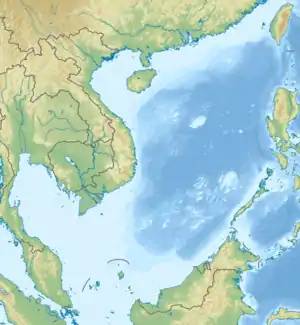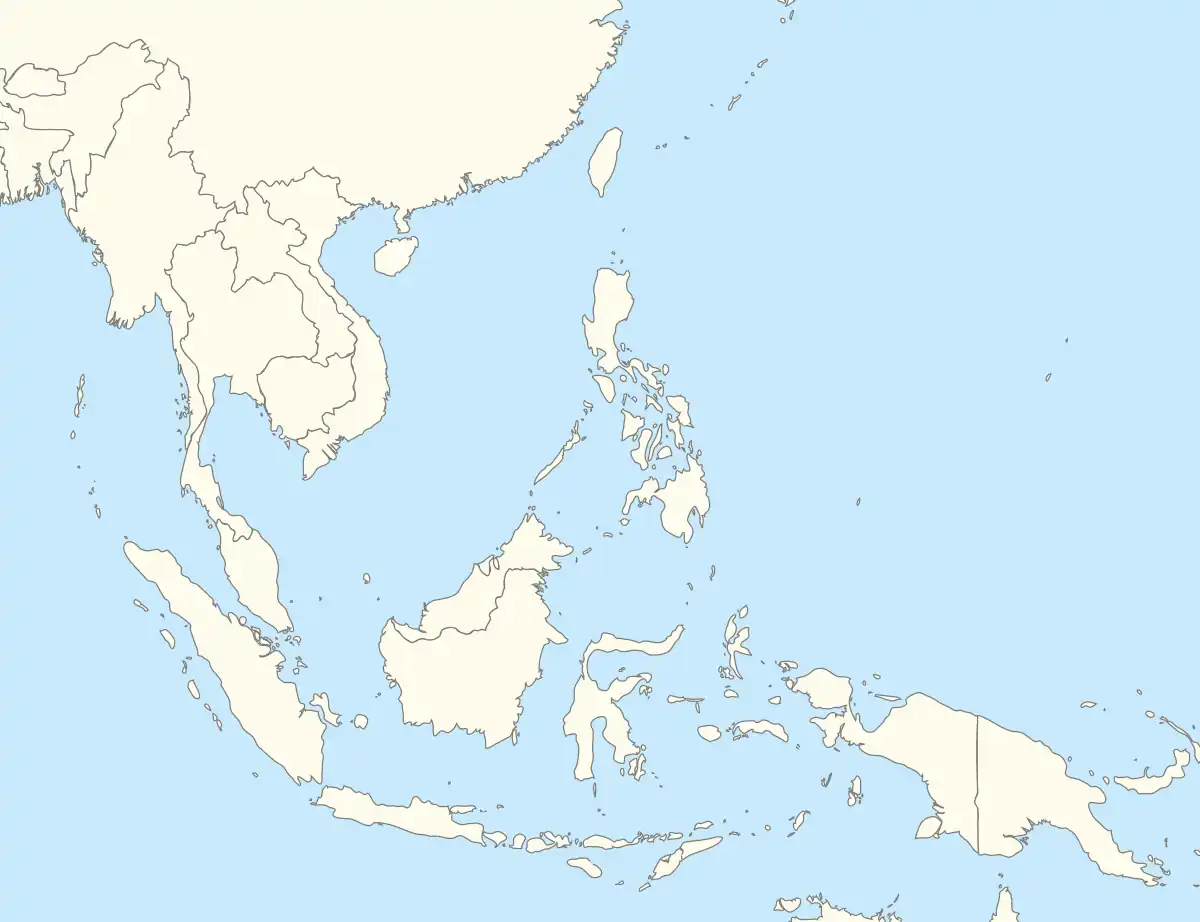| Palawan Passage | |
|---|---|
.svg.png.webp) Palawan Passage  Palawan Passage  Palawan Passage | |
| Location | Southeastern South China Sea |
| Coordinates | 10°00′00″N 118°00′00″E / 10.00000°N 118.00000°E |
| Max. width | 40 nmi (74 km; 46 mi) |
| Min. width | 35 nmi (65 km; 40 mi) |
| Islands | None |
The Palawan Passage is a natural waterway in the southeastern South China Sea to the west of the island of Palawan in the Philippine Islands. It is deep and relatively free of navigational hazards, making it an important shipping route. The entire Palawan Passage lies within the exclusive economic zone of the Philippines and in waters the Government of the Philippines refers to as the West Philippine Sea.
Geography
The Palawan Passage is a deep-water channel in the southeastern South China Sea lying between the island of Palawan in the Philippine Islands to its east and Dangerous Ground, an area of the South China Sea, to its west. It is centered roughly around 10°N 118°E / 10°N 118°E.[1]
The Palawan Passage is 35 to 40 nautical miles (65 to 74 km; 40 to 46 mi) wide.[2] Its eastern edge is marked by the 100-fathom (600 ft; 183 m) curve, which lies from 20 to 30 nautical miles (37 to 56 km; 23 to 35 mi) off the west coast of Palawan.[2] The area between the coast of Palawan and the 100-fathom curve is a bank studded with reefs and shoals.[2] To the west of the passage lies Dangerous Ground, a poorly surveyed and charted area of the southeastern South China Sea which includes numerous reefs, shoals, and rocks.[2] In contrast to the dangers to navigation in the waters to its east and west, the Palawan Passage offers a deep-water, northeast–southwest shipping channel with only two hazards in its fairway, Royal Captain Shoal with its northernmost point at Observation Rock at 09°02′N 116°39′E / 9.033°N 116.650°E, and Bombay Shoal with its northeastern extremity at Madagascar Rock at 09°26′N 116°56′E / 9.433°N 116.933°E.[3] The narrowest part of Palawan Passage lies between Royal Captain Shoal and the bank off Palawan.[4]
Typhoons rarely cross the Palawan Passage, although when they pass to its north they can create strong winds and unsettled weather in the passage.[2] Monsoon weather is somewhat unpredictable,[5] but generally the passage enjoys its calmest weather in May and early June.[4] In late June and July, weather becomes more unsettled, with periods of seven to ten days of rain, clouds, and squalls alternating with good weather.[4] A strong west-southwesterly wind usually blows along the passage during September and October, with dark clouds and rain common.[4] The weather is variable in November and December, with November particularly prone to strong southwesterly winds.[4] During the northeast monsoon, between October and December, the passage tends to enjoy calmer weather than the area of the South China Sea to the west of Dangerous Ground.[2] Currents in the Palawan Passage tend to be weak.[4]
The Palawan Passage offers a direct route from the Indian Ocean via the Sunda Strait to Manila in the Philippines, as well as an alternative to routes farther west in the South China Sea between Manila, Hong Kong and Singapore for ships seeking to avoid some of the rougher weather associated with the northeast monsoon.[2]
History
During the Pacific campaign of World War II, United States Navy submarines operated in the Palawan Passage to attack Japanese shipping. On October 23, 1944, the first day of the Battle of Leyte Gulf, the U.S. submarines USS Darter (SS-227) and USS Dace (SS-247) attacked an Imperial Japanese Navy task force under the command of Vice Admiral Takeo Kurita as it passed through the Palawan Passage on its way from Brunei to the Sibuyan Sea and San Bernardino Strait.[6] Darter torpedoed the heavy cruisers Atago — Kurita′s flagship — and Takao, sinking Atago and badly damaging Takao, and Dace torpedoed and sank the heavy cruiser Maya.[7] Takao turned back for Brunei, and as Darter and Dace shadowed her, Darter was wrecked without loss of life on Bombay Shoal. Takao eventually reached Singapore, but was never seaworthy again.
In 2011, the Government of the Philippines began to refer to the waters of the South China Sea that lie within the exclusive economic zone of the Philippines as the West Philippine Sea. The entire Palawan Passage lies within the West Philippine Sea.[8]
Cultural site
The Tabon Caves, a cave system at Quezon on Palawan and the site of prehistoric human remains and jar burials, is located at Lipuun Point between two arms of the Palawan Passage, Malanut Bay to the east and Nakoda Bay to the west.[9]
References
Footnotes
- ↑ Geographical Names: Palawan Passage: Philippines Accessed March 18, 2023
- 1 2 3 4 5 6 7 United States Coast Pilot, p. 127.
- ↑ United States Coast Pilot, pp. 129–130.
- 1 2 3 4 5 6 United States Coast Pilot, p. 128.
- ↑ United States Coast Pilot, pp. 127–128.
- ↑ Morison 1958, pp. 160, 171.
- ↑ Morison 1958, p. 170–172; Cutler 1994, p. 100; Hornfischer 2004, p. 120.
- ↑ Agence France-Presse (September 12, 2012). "Philippines renames coast 'West Philippine Sea'". South China Morning Post. Retrieved June 18, 2019.
- ↑ "NM Tabon Caves Site Museum". nationalmuseum.gov.ph. National Museum of the Philippines. 2021. Retrieved 25 October 2023.
Bibliography
- Cutler, Thomas (1994). The Battle of Leyte Gulf: 23–26 October 1944. Annapolis, Maryland: Naval Institute Press. ISBN 1-55750-243-9.
- Hornfischer, James D. (2004). The Last Stand of the Tin Can Sailors: The Extraordinary World War II Story of the U.S. Navy's Finest Hour. New York: Bantam. ISBN 0-553-80257-7. Retrieved 2 December 2020.
- Morison, Samuel E. (1958). Leyte, June 1944 – January 1945. History of United States Naval Operations in World War II. Vol. XII. Boston: Little & Brown. LCCN 47-1571. OCLC 1035611842. OL 24388559M. Retrieved 2 December 2020.
- United States Coast and Geodetic Survey (1940). Philippine Islands Part II: Palawan, Mindanao, and Sulu Archipelago, Third (1939) Edition. United States Coast Pilot. Washington, D.C.: United States Government Printing Office. Retrieved 18 March 2023.